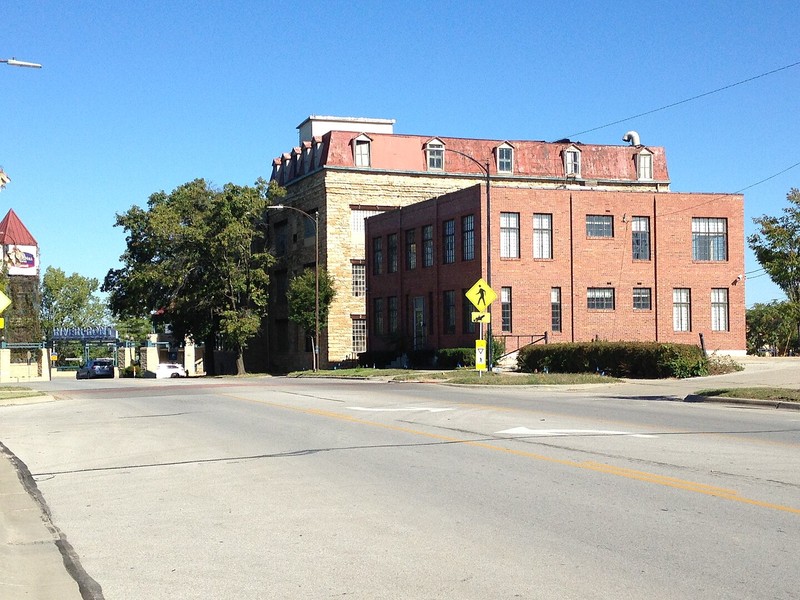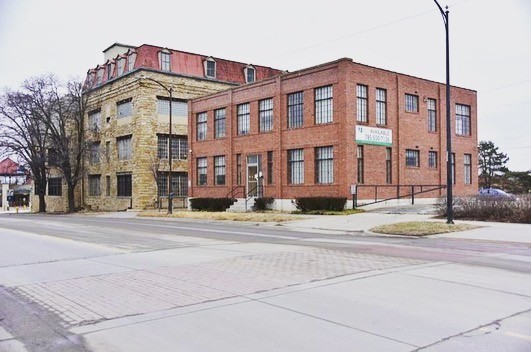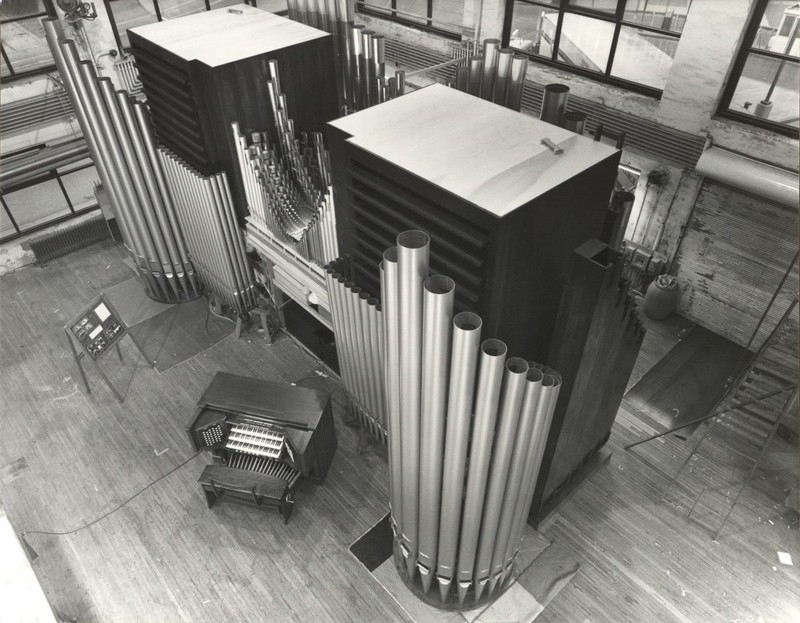Reuter Organ Company Buildings
Introduction
Text-to-speech Audio
These two downtown Lawrence structures were built in 1882 and 1927, with the first serving as the home to the Wilder Brothers Shirt Factory from 1882 to 1917. The Reuter Organ Company purchased the stone building in 1919 and used the property as its headquarters until 2001. the company also added the brick building in 1927. The organ company enjoyed immense success during the 1920s and survived the lean times associated with the Great Depression and World War II. By the 1950s, Reuter had rebounded fully and evolved into one of the nation's most prolific organ makers. The company operated from these historic structures in Lawrence until 2001 and sold the former factory building to Harvesters the following year.
Images
Reuter Organ Company Buildings

Reuter Organ Company Buildings

Reuter Organ Company’s Opus 2179 at the Elm Park Methodist Church in Scranton, Pennsylvania, 1995.

Backstory and Context
Text-to-speech Audio
J. Frank and Charles E. Wilder founded the Wilder Brothers Shirt Factory in 1870, during a brief economic boom and population expansion period in Lawrence during the late 1860s and early 1870s. The brothers came to Lawrence in 1870 from Troy, New York, where they worked for a shirt manufacturer. The brothers opened a business in Lawrence that specialized in made-to-order shirts and men's underwear, and they provided laundry services. Despite an economic downturn and significant population decline during the late 1870s, Wilder Brother's business continued to thrive, leading them to expand to a more extensive facility; hence, they constructed the now-historic structure in 1882. The brothers initially stood at three stories, supported sixty-five employees, and utilized water power from the Kansas (Kaw) River to operate their sewing machines. The company added a fourth story in 1890. By 1906, Wilder Brothers Shirt Factory produced twenty-thousand shirts annually, and they employed seventy factory workers and twenty traveling salespeople. However, the peak occurred in the years before World War I; the factory shut its doors in 1916 and sold the building in 1917.
What became the Reuter Organ Company in 1919 began as the Reuter-Swharz Organ Company in Trenton, Illinois, in 1917. The historic building's namesake, Adolph Reuter, started his career at the Barckhoff Organ Company in Pomeroy, Ohio, where he worked and learned the trade from 1901 to 1908. From 1908 to 1912, Reuter served as shop superintendent for the Wicks Organ Company in Highland, Illinois; his nephew Albert Sabol joined him at Wicks. He then worked briefly for another organ company in South Haven, Michigan, before the Pilcher Organ Company, based in Kentucky, hired him in 1913, where he remained until Earl Schwarz and Henry Jost hired him and Sabol in 1917 to manage an organ-building operation, which became the Reuter-Schwarz Organ Company.
The Reuter-Schwarz Organ Company began operations in a small building in Trenton. The company only built one organ in its first year of operation, assembling an organ for Trinity Episcopal Church in Mattoon, Illinois. However, the company expanded its output to ten organs in 1918 and fourteen in 1919. With the expansion came a need for a newer, larger factory. With an organ company in nearby Highland, Illinois, and another in St. Louis, the Reuter-Schwarz Organ Company Board of Directors decided to move the company elsewhere, deciding on three possibilities in Kansas: Lawrence, Lindsborg, and Winfield. The decision grew easier when the Masonic Temple in Lawrence commissioned an organ from Reuter-Schwarz. The company relocated from Illinois to Lawrence that year (1919) and subsequently purchased the vacant Wilder Brothers shirt factory building. Shortly after the move from Illinois to Kansas, Schwarz left the company; thus, the company became known as Reuter Organ Company (incorporated in Kansas on September 15, 1919).
The former shirt factory building appealed to the organ company because of its proximity to the river and dam(access to water power) and the nearby railroad, which allowed for easy shipping of organs throughout the nation. Reuter-Schwarz renovated the stone building and constructed additions used as an organ assembly room and a lumber kiln. Reuter Organ Company assembled its first organ in the new building and delivered it to Central Congregational Church in Topeka, Kansas, on May 24, 1920; they built fourteen organs in that first year of operation. The company benefited from the expanding economy of the 1920s and the increased popularity of theatres, constructing forty-five to fifty organs every year from 1926 to 1929, employing more than fifty workers, and adding the two-story concrete and brick building in 1927, connected by a metal walkway.
The company survived the Great Depression and World War II, but endured several challenges. Production slowed substantially in the early 1930s. From 1932 to 1934, the company only operated three days per week, and then they decided to open as needed (when they received a contract). Reuters completed eleven organs in 1933 and nine in 1934, mainly smaller organs for private residences and funeral homes. Production slowly increased by the late 1930s, exceeding forty contracts by 1941. However, the United States entered World War II, and with it came a ban on materials used in organ making. As a result, the factory closed in 1942. Near the war's end, Reuter won a contract to build shipping boxes for munitions materials, allowing the factory to reopen with a skeleton crew.
Finally, in the mid-1940s, with the war and Great Depression behind the nation, the company and economy rebounded. By 1948, Reuter Organ Company stood as the only organ company between St. Louis and California. In the decade that followed the war, many of Reuter's Board of Directors and employees held college degrees in music or were trained organists, which helped in the design and engineering of new organs and allowed the company to foster relationships with colleges and universities; Reuters started its post-war operations by producing an organ for the University of Nebraska in 1945. The company's success resulted in immense sales growth, exceeding $600,000 in 1953, $800,000 in 1958, and eclipsing the $1 million mark in 1961.
The company had its ups and downs in the late twentieth century, usually associated with the overall health of the U.S. economy, but generally evolved into one of the nation's foremost organ makers. Indeed, approximately twenty organ companies operated nationwide when the company began as a small Illinois operation in 1917. By the early 1990s, Reuter existed as one of six remaining organ companies and stood as the second largest organ maker in the country in 1999.
The company moved out of the historic building in 2001 and continued in a newer 75,000-square-foot facility until the early 2020s (celebrating its centennial anniversary in 2017). In 2020, Reuter produced thousands of organs and shipped them throughout the country and international locations as Canada, Taiwan, and South Korea. However, the company sold their factory in 2023 and announced plans to slowly cease operations, with no plans to hire new employees after they leave or retire.
Cite This Entry
Powers, Mathew and Clio Admin. "Reuter Organ Company Buildings." Clio: Your Guide to History. January 20, 2024. Accessed March 31, 2025. https://theclio.com/entry/177312
Sources
"Company History." The Reuter Organ Company. reuterorgan.com. Accessed January 19, 2024. https://www.reuterorgan.com/about.
Dunleavy, Alison and Amanda K. Loughlin. "Registration Form: Reuter Organ Company Buildings." National Register of Historic Places. kshs.org. 2020. https://www.kshs.org/resource/national_register/nominationsNRDB/KS_DouglasCounty_HistoricResourcesofLawrenceMPDF_ReuterOrganCompanyBuildings_Listed12212020.pdf.
Pincock, Charissa. "Spencer's November-December Exhibit: 'Creating Over a Century of Symphonies: The Reuter Organ Company'." Kansas University Kenneth Spencer Research Library, Inside Spencer: The KSRL Blog. November 14, 2023. https://blogs.lib.ku.edu/spencer/spencers-november-december-exhibit-creating-over-a-century-of-symphonies-the-reuter-organ-company/.
By Abir Haque - Own work, CC BY-SA 4.0, https://commons.wikimedia.org/w/index.php?curid=111959704
Lawrence Preservation Alliance via Facebook at https://www.facebook.com/photo/?fbid=3698309330207647&set=pcb.3698309413540972
Photo credit: Max Mayse. Reuter Organ Company Photograph Collection. Call Number: RH PH 68. Located at https://blogs.lib.ku.edu/spencer/spencers-november-december-exhibit-creating-over-a-century-of-symphonies-the-reuter-organ-company/

